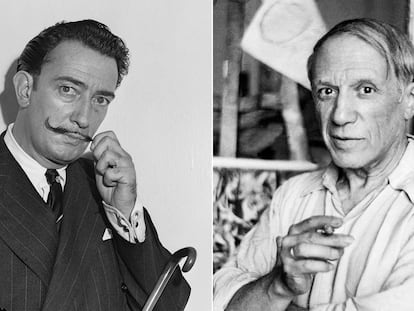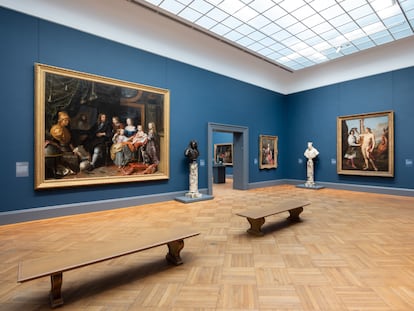The market heats up for Picasso’s ceramics
The rise of pottery as an artistic discipline and the artist’s large body of earthen works, with pieces priced at as little as $500 and as much as $3 million, have prompted the sale of almost all of the pottery created by the famous painter

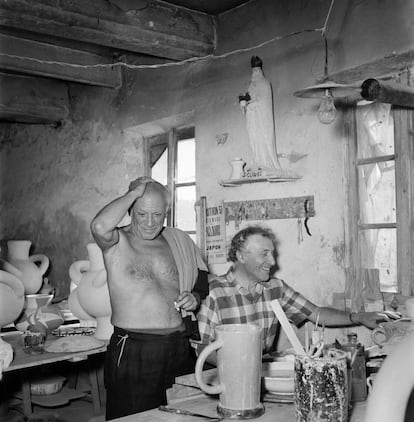
When Picasso learned to bake and shape the earth, everything changed. He transformed a craft — pottery — into an art. In 2023, works by the artist in the category of “decorative arts” sold for a total of $16,983,850 (prior to November 11, and according to the art information platform MutualArt.com). Up for auction were 1,468 ceramic pieces, of which 1,098, or 75% of the total, were sold. On October 30, the global auction house Christie’s put 89 pieces on the market. All of them sold, bringing in just over $3 million. Christie’s top competitor, Sotheby’s, also proved that the fire of genius is as profitable as ever. The seller held two auctions of ceramics, one in April, in London, and another in September, in New York. A total of 176 works were sold, or 96% of the total available. Collectors from 35 countries bid on the pieces. There were some surprises, too: Visage aux yeux rieurs (Face with laughing eyes, in English), a glazed ceramic pitcher, fetched a staggering 165,100 pounds sterling (more than $210,000), setting a world record for that piece of white fired clay. To some, it may sound like a “reasonable” amount when talking about a Picasso. But it is a ceramic jug that was reproduced 350 times, with a starting price set at 40,000 pounds.
Many things have happened to bring us to this point. Some during the master’s lifetime, others in the years after his death. There is no catalogue raisonné listing all of Picasso’s ceramic works. It is estimated that there are some 3,500 unique pieces, but there are at least 1,000 that remain missing and have never been exhibited. “Moreover, there has been a radical change in the historiography,” says Salvador Haro, professor of painting at the University of Málaga and one of the world’s leading experts on ceramic art. “They are no longer just ‘knick-knacks from the artist’s latter years.’ Researchers have become interested in his creations and several exhibitions have added significant value to his ceramics.” For Picasso, Haro says, 1998 was an essential year. “The Metropolitan in New York and the Royal Academy of Arts in London both programmed exhibitions, and for the first time, there was a good catalog, and it completely changed the paradigm,” he says. The growing interest has also been influenced by the unconscious calculations driving today’s collector: “For just 500 euros I can own something similar to a sculpture.”
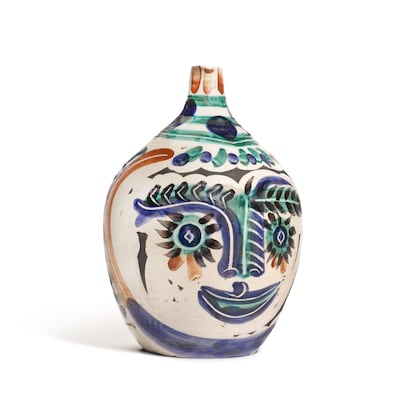
“Before Picasso,” writes Haro, “other painters had dabbled in the ceramic arts: Gauguin, Matisse, Rouault, Marquet, Dufy, Fontana, Kandinsky. However, their performances in this medium, often marginal to their main endeavors, were not taken very seriously by critics.” But the demiurge Picasso had reinvented 20th century artistic expression, and pottery would be no exception.
It had been a year since the signing of the armistice that ended the Second World War. At the time, Picasso was spending the summer with Françoise Gilot in Golfe-Juan, on the French Riviera. One afternoon, at the end of July, they went to see an exhibition of handicraft products on display near Vallauris, an epicenter of pottery since Roman times that the artist had already visited in 1936 with Dora Maar and the poet Paul Éluard. He was fascinated, in those days, watching the potters form their clay.
On the Côte d’Azur, Picasso met the Ramiés, a husband and wife who had reopened an old pottery factory called Madoura. That same afternoon, he was already at the potter’s wheel, creating clay figures, and was immediately drawn to the artform. He would spend that winter drawing sketches for future ceramic pieces. He worked with Jules Agard, an expert lathe operator, and the Ramié family provided him with an infinite supply of materials. He spent most of 1947 in Madoura. A fire had sparked inside him that he fed relentlessly. Every evening, Salvador Haro recalls, the artist would come from Golfe-Juan — where he had rented a summer house from the engraver Louis Fort, until moving in the spring of 1948 to a new residence in Vallauris, in the villa La Galloise — together with Gilot and their newborn son Claude. They lived there until 1954. During those years, Picasso never stopped working with clay.
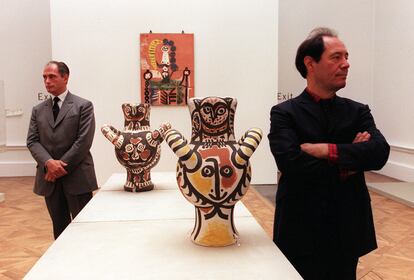
His idea, he explained to George Remié, the owner of the workshop, was to make the pieces available to everyone by creating numerous reproductions, just as he had done with engravings since 1946. The works were thus reproduced in series starting in 1950, though the first models were originals created during 1947. Before this high production phase, in 1948, Picasso exhibited his ceramic works at the Maison de la Pensée Française in Paris. Critics were divided. But it was Picasso, and it had an unexpected effect. The pottery industry came back to life after World War II. In Vallauris there were 400 to 500 unemployed pottery workers, but “after he showed his exhibition in the French capital [in 1948], to the crowds that came to see it, you could have dug up the dead potters and found them work,” explained Georges Tabaraud, editor of Le Patriote, a French communist newspaper and Picasso’s friend. Lucio Fontana, Paul René Gauguin (Paul Gauguin’s nephew), the painter Edouard Pignon and Joan Miró all passed through the doors of the workshop. Marc Chagall also spent time there, something that annoyed Picasso. He represented the avant-garde; Chagall, on the other hand, was, in his opinion, reactionary and very distant politically from Picasso’s leftist ideas and affinity with Russia.
Despite his temperament, Picasso elevated pottery above the level of mere tradition, opening a new path for other creators. At the same time, he invented a market. The three all-time highest selling “decorative” Picasso pieces (according to MutualArt.com) were 23 silver bowls, which sold for 2,657,000 euros in 2014. These are followed by two unique clay owl sculptures: Le hibou gris, from 1953, which sold for $2,412,500 in 2018, and Le hibou (rouge et blanc), which sold for $2,407,500 in 2016. Works measuring no more than a foot in length or width. But there are more affordable pieces too, starting at around $500 to $700. Picasso was a genius, and he knew how to make the earth and money burn.
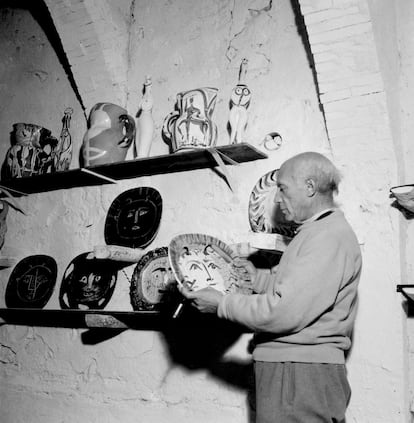
Sign up for our weekly newsletter to get more English-language news coverage from EL PAÍS USA Edition
Tu suscripción se está usando en otro dispositivo
¿Quieres añadir otro usuario a tu suscripción?
Si continúas leyendo en este dispositivo, no se podrá leer en el otro.
FlechaTu suscripción se está usando en otro dispositivo y solo puedes acceder a EL PAÍS desde un dispositivo a la vez.
Si quieres compartir tu cuenta, cambia tu suscripción a la modalidad Premium, así podrás añadir otro usuario. Cada uno accederá con su propia cuenta de email, lo que os permitirá personalizar vuestra experiencia en EL PAÍS.
¿Tienes una suscripción de empresa? Accede aquí para contratar más cuentas.
En el caso de no saber quién está usando tu cuenta, te recomendamos cambiar tu contraseña aquí.
Si decides continuar compartiendo tu cuenta, este mensaje se mostrará en tu dispositivo y en el de la otra persona que está usando tu cuenta de forma indefinida, afectando a tu experiencia de lectura. Puedes consultar aquí los términos y condiciones de la suscripción digital.
More information
Archived In
Últimas noticias
James Cameron: ‘For the films I like to make to continue to exist, we have to find a way to make them cheaper’
Families demand repatriation of bodies of Colombians who died in Ukraine: ‘This war is a slaughterhouse for foreigners’
The guardians of the meteorites of the Argentine Chaco
Helen Levitt, the photographer who captured the theater of the everyday
Most viewed
- Christian Louboutin: ‘Young people don’t want to be like their parents. And if their parents wear sneakers, they’re going to look for something else’
- US sanctions against jailed cartel leader ‘El Marro’ highlight Mexico’s lack of control over its prisons
- Cartels in Mexico take a leap forward with narco-drones: ‘It is criminal groups that are leading the innovation race’
- Liset Menéndez de la Prida, neuroscientist: ‘It’s not normal to constantly seek pleasure; it’s important to be bored, to be calm’
- ‘El Limones’ and the growing union disguise of Mexican organized crime
